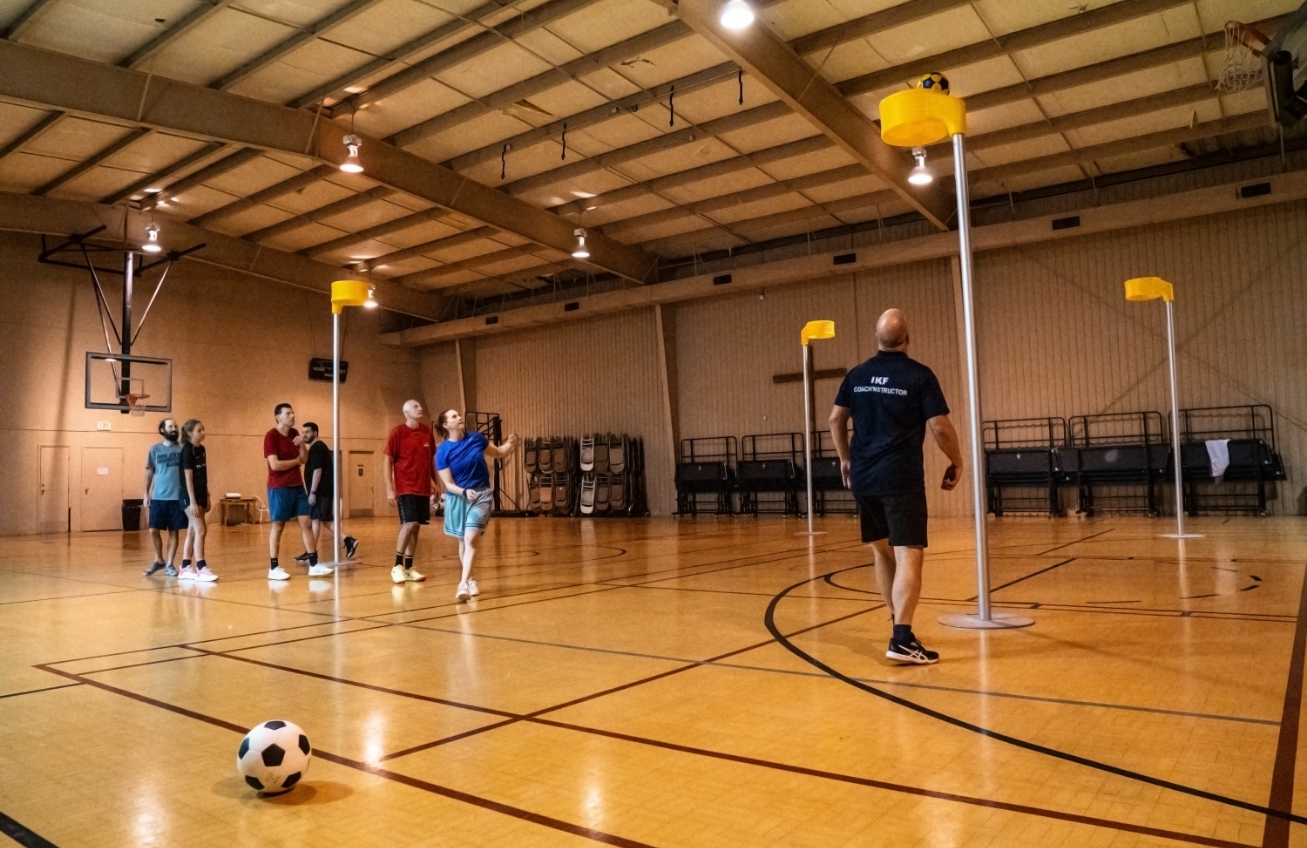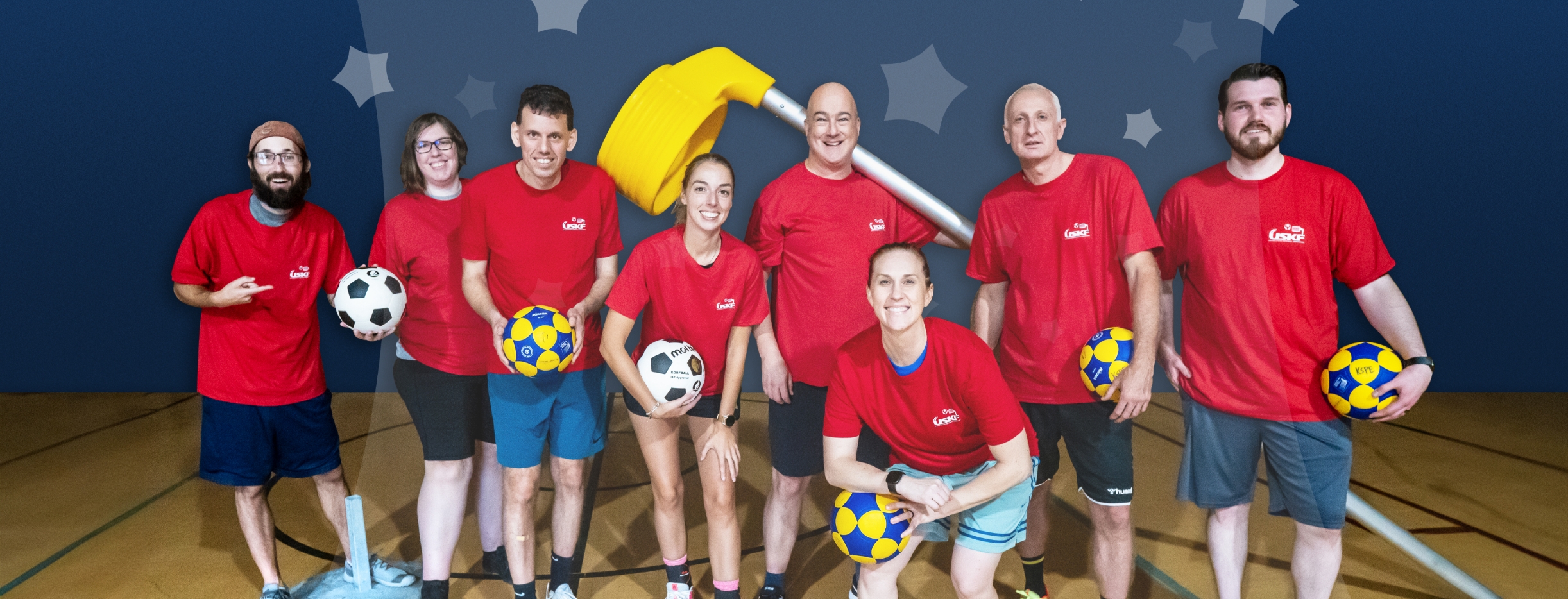Korf Dreams
A little goofy, a lot of fun, korfball is a unique game that Carl Yerger ’05 wants everyone to experience
Carl Yerger ’05 has a dream. he wants korfball, a European version of basketball, to become one of the nation’s most popular sports. For the past eight years as president of the United States Korfball Federation (USKF), Yerger, a Davidson College math professor, has sung the praises of this obscure game to students, lobbied gym teachers and hustled to create korfball clubs around the nation.
Korf means basket in Dutch. In 1902, a Netherlands schoolteacher wanted girls and boys to play a team sport together. He modeled his new game after the rules of early women’s basketball which limited contact and height advantages.
Today korfball is played by about a million people in 70 nations. True to its gender equality origins, the fast-paced game has four men and women on each side. Yellow plastic korfs sit atop eleven-and-half foot tall poles at either end of the basketball-sized court. Dribbling or running with the soccer-sized ball is forbidden. There’s little physical contact.
“In korfball you do so many different things. You pass. You run. You shoot. Men and women work together as a team. It’s perfect for gym class. It’s such a unique game. It’s not just about who’s the biggest or the strongest,” says Yerger, who was introduced to the game while getting his master’s at Cambridge.
He had played varsity tennis while at Harvey Mudd and discovered a thriving korfball league at his new school. “It seemed a little goofy and a little fun and a way to meet people outside of the math department. I was athletic, so I thought let’s give this korfball a try,” he recalls.
Even though men and women compete against each other in mixed tennis doubles and ultimate Frisbee, the International Korfball Federation boasts that korf, as players often call it, is the world’s best mixed-team sport.
To minimize any advantage, males or tall people might have players only guard members of their own sex. No one can take a shot when a defender is within arm’s reach. The 6-foot-1-inch, Yerger admits his height advantage helps but says it’s not “exclusively important,” because of the defended shot rule.
Constant and intense collaboration puts korfball in a superior gender-mixing league of its own, according to him. “Korfball is about working together. It has a very different vibe from other sports, because it’s about togetherness,” he says. “Men and women go to work together, and sports should be no different in that regard.”
A recent New York Times article on korfball gave the game a much- needed publicity boost. The story said transgendered athletes might find a controversy-free home on korfball pitches. When asked about that, Yerger says, “The International Korfball Federation is working on guidelines. We want to get everyone to play korfball. We don’t want to have division.”
Yerger knows what it’s like to be told he can’t compete. He was at Georgia Tech in 2007 working on his PhD in the Algorithms, Combinatorics and Optimization program and hoped to play in the World Championships in Brno, Czech Republic, that October. But he and other U.S. players were unable to take part in qualifying tournaments due to time and expense constraints. “That’s one of the systemic challenges U.S. korfball faces,” he says.
Former USKF president Rebecca Shields praises Yerger. Besides being a “good rebounder and great team player,” she thinks he can lead the game into a more popular future. “Carl brought us into the What’s-our-vision, what-are-we- hoping-to-accomplish mode,” she says.
Though life as president of the nation’s korfball association is frustrating. For those wanting to start teams, the cost of equipment can be prohibitive—as much as $1,500 for a base, pole and basket which is patented and must be imported from Europe.

Introducing the game at the grass roots level in schools has been a priority—and a struggle. The USKF ran tournaments at Hamilton College and Hope College. Nothing lasting resulted even though Hope is in Holland, Michigan, which has a large population of Dutch immigrant descendants.
Yerger hoped to give the game deep roots in Birmingham, Alabama, schools in 2016. The World Games was going to be held there in 2022. He wanted to build a cadre of seasoned players who might form the nucleus of a national team.
To boost the odds of success, korfball leaders from the Netherlands, the world’s powerhouse in the sport, flew over. The former Dutch national coach led seminars. A former player of the decade was one of four Dutch demonstrators. As many as 30 students attended for several days. Then disaster.
“One day there was football practice, and those kids didn’t come. In the U.S., sports culture is so strong, students feel they need to be committed to only one thing,” says Yerger. In the end, the U.S. was unable to even try out for the Birmingham games.
Today, several thousand school children play korfball in gym classes. If the U.S. tried to field a national team, there might only be about 50 Americans able to play at the international level, according to Yerger.
“Working to grow the game is a perpetual disappointment, but it’s fun because we’re all obsessed with korfball. You have to be ready to hear ‘No’ a lot and still want to keep at it. You have to be persistent,” he says.
When not promoting the sport, Yerger leads the math club for Charlotte, North Carolina, students. He’s also co-editor- in-chief of the AMC 10/12 exam. Run by the Mathematical Association of America, this test is taken annually by more than 200,000 teens around the world to use for college admissions.
Students in Yerger’s math classes know all about korfball. He often sneaks korf- related questions into exams. One begins, “A survey of consumers in Davidson shows that 10% were dissatisfied with their child’s korfball coach.” Another presents a matched-pairs experiment comparing mean reaction times to korfball moves.
The growth potential of beach korfball excites Yerger. It requires fewer players and less equipment. Tournaments are shorter and mostly in the summer, and the sandy spinoff allows more playing offense and defense at the same time. This year, Yerger visited Hungary as part of the Budapest Semesters in Mathematics Director’s Mathematician in Residence program) and was able to help officiate youth and adult games there. A national tournament is planned in Cincinnati in September.
When reminded that 50 years ago youth soccer was far from mainstream, Yerger thinks a similar explosion of interest could happen with korfball. “I’d be excited to see such an opportunity,” he says. “All it might take is for a pocket or two of korfball to develop and for there to be a viral moment.”
Above all else, one objective keeps Yerger going: “Beat the Dutch. Everyone wants to beat the Dutch. That’s the goal.”
Korfball Facts
- Invented in 1902 by a Dutch teacher
- Two teams of eight players, four male and four female
- The goal? Toss a ball into a netless basket (the korf) on an 11 ½-foot pole
- No dribbling or running with the ball
- No shooting if a defender is in arm’s length
- Men defend men. Women defend women
- Played in 70 nations; most popular in the Netherlands, Belgium, Taiwan and China
- Seeking inclusion in the 2032 Olympics in Brisbane, Australia
